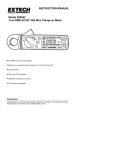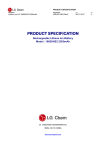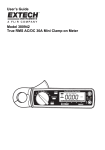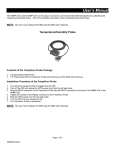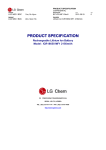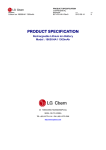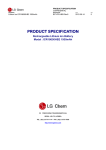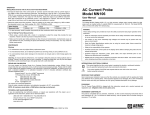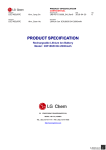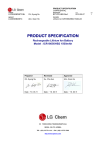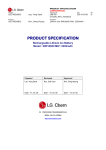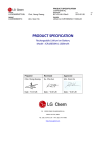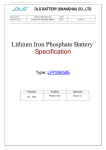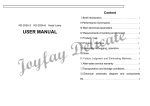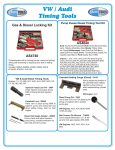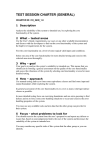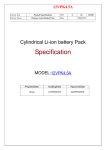Download PRODUCT SPECIFICATION
Transcript
PRODUCT SPECIFICATION Description Document No. Date Rev Lithium Ion LG 18650HE4 2500mAh BCY-PS-HE4-Rev0 2013-05-30 0 PRODUCT SPECIFICATION Rechargeable Lithium Ion Battery Model : 18650HE4 2500mAh LG Twin Towers 128, Yeoui-daero, Yeongdeungpo-gu, Seoul, Republic of Korea, 150-721 http://www.lgchem.com PRODUCT SPECIFICATION Description Document No. Date Rev Lithium Ion LG 18650 HE4 2500mAh BCY-PS-HE4-Rev0 2013-05-30 0 Revision History Revision Date Originator 0 2013-05-30 Kim Hyoungkwon Description - Original Release 2/10 PRODUCT SPECIFICATION Description Document No. Date Rev Lithium Ion LG 18650 HE4 2500mAh BCY-PS-HE4-Rev0 2013-05-30 0 Contents Contents …………………………………………………………………………….……………………………. 3 1. General Information ……………………………………………………………………………………… 4 1.1 Scope 1.2 Application 1.3 Product Classification 1.4 Model Name 2. Nominal Specification …………………………………………………………………………………… 4 2.1 Nominal Capacity 2.2 Nominal Voltage 2.3.1 Standard Charge 2.3.2 Fast Charge 2.4 Max. Charge Voltage 2.5 Max. Charge Current 2.6.1 Standard Discharge 2.6.2 Fast Discharge 2.7 Max. Discharge Current 2.8 Weight 2.9 Operating Temperature 2.10 Storage Temperature (for shipping state) 3. Appearance and Dimension ……………………………………………….………………………… 5 3.1 Appearance 3.2 Dimension 4. Performance Specification ……………………………………………………………………………. 5 4.1 Standard Test Condition 4.2 Electrical Specification 4.3 Environmental Specification 4.4 Mechanical Specification 4.5 Safety Specification 5. Cautions and Prohibitions in Handling ……………………………….………………………… 8 3/10 PRODUCT SPECIFICATION Description Document No. Date Rev Lithium Ion LG 18650 HE4 2500mAh BCY-PS-HE4-Rev0 2013-05-30 0 1. General Information 1.1 Scope This product specification defines the requirements of the rechargeable lithium ion battery to be supplied to the customer by LG Chem. 1.2 Application: Power Tools 1.3 Product classification: Cylindrical rechargeable lithium ion battery 1.4 Model name: 18650 HE4 2. Nominal Specification Item Condition / Note Specification 2.1 Capacity Std. charge / discharge Nominal 2500 mAh (Cnom) 2.2 Nominal Voltage Average for Std. discharge 3.60V 2.3.1 Standard Charge Constant current 1250mA (Refer to 4.1.1) Constant voltage 4.2V End condition(Cut off) 50mA 2.3.2 Fast charge Constant current 4000mA (Refer to 4.1.3) Constant voltage 4.2V End condition(Cut off) 100mA 2.4 Max. Charge Voltage - 4.20±0.05V 2.5 Max. Charge Current - 4000mA 2.6.1 Standard Discharge Constant current 500mA (Refer to 4.1.2) End voltage(Cut off) 2.5V 2.6.2 Fast Discharge Constant current 10000mA, 20000mA (Refer to 4.1.3) End voltage(Cut off) 2.5V 2.7 Max. Discharge Current For continuous discharge 20000mA 2.8 Weight Max. 47.0 g 2.9 Operating Temperature Charge (Cell Surface Temperature) Discharge -20 ~ 75℃ 2.10 Storage Temperature 1 month -20 ~ 60℃ 3 month -20 ~ 45℃ 1 year -20 ~ 20℃ i (for shipping state ) 0 ~ 50℃ * Shipping state : About 40% capacity of fully charged state 4/10 PRODUCT SPECIFICATION Description Document No. Date Rev Lithium Ion LG 18650 HE4 2500mAh BCY-PS-HE4-Rev0 2013-05-30 0 3. Appearance and Dimension 3.1 Appearance There shall be no such defects as deep scratch, crack, rust, discoloration or leakage, which may affect the commercial value of the cell. 3.2 Dimension Diameter : 18.3 + 0.2/-0.3 mm ( Max. 18.5 mm ) Diameter is defined as the largest data value measured on the “A” area of a cylindrical cell. Height : 65.0 ± 0.2 mm ( Max. 65.2 mm ) ±0.2 18.3 +0.2/-0.3 4. Performance Specification 4.1 Standard test condition 4.1.1 Standard Charge Unless otherwise specified, “Standard Charge” shall consist of charging at constant current of 1250mA. The cell shall then be charged at constant voltage of 4.2V while tapering the charge current. Charging shall be terminated when the charging current has tapered to 50mA. For test purposes, charging shall be performed at 23ºC ± 2ºC. 5/10 PRODUCT SPECIFICATION Description Document No. Date Rev Lithium Ion LG 18650 HE4 2500mAh BCY-PS-HE4-Rev0 2013-05-30 0 4.1.2 Standard Discharge “Standard Discharge” shall consist of discharging at a constant current of 500mA to 2.5V. Discharging is to be performed at 23 ºC ± 2 ºC unless otherwise noted (such as capacity versus temperature). 4.1.3 Fast Charge / Discharge condition Cells shall be charged at constant current of 4000mA to 4.2V with end current of 100mA. Cells shall be discharged at constant current of 10000mA and 20000mA to 2.5V. Cells are to rest 10 minutes after charge and 30 minutes after discharge. 4.2 Electrical Specification Item Condition Specification 4.2.1 Cell shall be measured at 1kHz after charge per ≤ 20 mΩ, without PTC Initial AC Impedance 4.1.1. 4.2.2 Cell shall be charged per 4.1.1 and discharged Initial Capacity per 4.1.2 within 1h after full charge. 4.2.3 Cells shall be charged and discharged per Cycle Life 4.1.3, 300 cycles(10A) and 200 cycles(20A) .A 2500 mAh (Cnom) ≥ 60 % (of Cnom in 2.1) cycle is defined as one charge and one discharge. 301 st (10A) and 201 st (20A) discharge capacity shall be measured per 4.1.1 and 4.1.2 4.3 Environmental specification. Item Condition Specification 4.3.1 Cells shall be charged per 4.1.1 and stored in a Capacity remaining rate Storage Characteristics temperature-controlled environment at 23ºC ± ≥ 90% (of Cnom in 2.1) 2ºC for 30 days. After storage, cells shall be discharged per 4.1.2 to obtain the remaining capacity. 4.3.2 Cells shall be charged per 4.1.1 and stored in a No leakage, High Temperature temperature-controlled environment at 60ºC for Capacity recovery rate ≥ Storage Test 1 week. After storage, cells shall be discharged 80% (of Cnom in 2.1) per 4.1.2 and cycled per 4.1.1 and 4.1.2 for 3 cycles to obtain recovered capacity. * Remaining Capacity : After storage, cells shall be discharged with standard condition(4.1.2) to measure the remaining capacity. ** Recovery Capacity : After storage, cells shall be discharged with standard discharge condition(4.1.2), and then cells shall be charged with standard charge condition(4.1.1), and then discharged with standard discharge condition(4.1.2). This charge / discharge cycle shall be repeated three times to measure the recovery capacity. 6/10 PRODUCT SPECIFICATION Description Document No. Date Rev Lithium Ion LG 18650 HE4 2500mAh BCY-PS-HE4-Rev0 2013-05-30 0 4.3.3 65ºC (8h) ← 3hrs → -20ºC (8h) for 8 cycles No leakage Thermal Shock Test with cells charged per 4.1.1 After test, cells are Capacity recovery rate ≥ discharged per 4.1.2 and cycled per 4.1.1 and 80% (of Cnom in 2.1) 4.1.2 for 3 cycles to obtain recovered capacity. 4.3.4 Cells shall be charged per 4.1.1 at 23ºC ± 2ºC Temperature and discharged per 4.1.2 at the following Dependency of temperatures. Capacity Charge Discharge Capacity -10℃ 60% (of Cnom in 2.1) 0℃ 80% (of Cnom in 2.1) 23℃ 100% (of Cnom in 2.1) 60℃ 95% (of Cnom in 2.1) 23℃ 4.4 Mechanical Specification Item Condition Specification 4.4.1 Cells charged per 4.1.1 are dropped onto an oak board No leakage Drop Test from 1 meter height for 1 cycle, 2 drops from each cell No temperature rising terminal and 1 drop from side of cell. (Total number of drops =3). 4.4.2 Cells charged per 4.1.1 are vibrated for 90 minutes per Vibration Test each of the three mutually perpendicular axes (x, y, z) No leakage with total excursion of 0.8mm, frequency of 10Hz to 55Hz and sweep of 1Hz change per minute. 4.5 Safety Specification Item Condition Specification Cells are discharged per 4.1.2, then charged at constant 4.5.1 current of 3 times the max. charge condition and Overcharge Test constant voltage of 4.2V while tapering the charge No explosion, No fire current. Charging is continued for 7 hours (Per UL1642). 4.5.2 Cells are charged per 4.1.1, and the positive and External Short - negative terminal is connected by a 100 mΩ-wire for 1 Circuiting Test hour (Per UL1642). 7/10 No explosion, No fire PRODUCT SPECIFICATION Description Document No. Date Rev Lithium Ion LG 18650 HE4 2500mAh BCY-PS-HE4-Rev0 2013-05-30 0 4,5.3 Overdischarge Test Cells are discharged at constant current of 0.2C to 250% of the minimum capacity. No explosion, No fire Cells are charged per 4.1.1 and heated in a circulating 4.5.4 air oven at a rate of 5ºC per minute to 130ºC. At 130ºC, Heating Test oven is to remain for 10 minutes before test is No explosion, No fire discontinued (Per UL1642). Cells charged per 4.1.1 are impacted with their 4.5.5 longitudinal axis parallel to the flat surface and Impact Test perpendicular to the longitudinal axis of the 15.8mm No explosion, No fire diameter bar (Per UL1642). 4.5.6 Crush Test Cells charged per 4.1.1 are crushed with their longitudinal axis parallel to the flat surface of the No explosion, No fire crushing apparatus (Per UL1642). 5. Caution Warning for using the lithium ion rechargeable battery. Mishandling of the battery may cause heat, fire and deterioration in performance. Be sure to observe the following. 5.1 Cautions for Use and Handling When using the application equipped with the battery, refer to the user’s manual before usage. Please read the specific charger manual before charging. Charge time should not be longer than specified in the manual. When the cell is not charged after long exposure to the charger, discontinue charging. Battery must be charged at operating temperature range 0 ~ 45℃. Battery must be discharged at operating temperature range -20 ~ 60℃. Please check the positive (+) and negative(-) direction before packing. When a lead plate or wire is connected to the cell for packing, check out insulation not to short-circuit. Battery must be stored separately. Battery must be stored in a dry area with low temperature for long-term storage. Do not place the battery in direct sunlight or heat. Do not use the battery in high static energy environment where the protection device can be damaged. When rust or smell is detected on first use, please return the product to the seller immediately. The battery must be away from children or pets When cell life span shortens after long usage, please exchange to new cells. 8/10 PRODUCT SPECIFICATION Description Document No. Date Rev Lithium Ion LG 18650 HE4 2500mAh BCY-PS-HE4-Rev0 2013-05-30 0 5.2 Prohibitions Do not use different charger. Do not use cigarette jacks (in cars) for charging. Do not charge with constant current more than maximum charge current. Do not disassemble or reconstruct the battery. Do not throw or cause impact. Do not pierce a hole in the battery with sharp things. (such as nail, knife, pencil, drill) Do not use with other batteries or cells. Do not solder on battery directly. Do not press the battery with overload in manufacturing process, especially ultrasonic welding. Do not use old and new cells together for packing. Do not expose the battery to high heat. (such as fire) Do not put the battery into a microwave or high pressure container. Do not use the battery reversed. Do not connect positive(+) and negative(-) with conductive materials (such as metal, wire) Do not allow the battery to be immerged in or wetted with water or sea-water. 9/10 PRODUCT SPECIFICATION Description Document No. Date Rev Lithium Ion LG 18650 HE4 2500mAh BCY-PS-HE4-Rev0 2013-05-30 0 5.3 Caution for the battery and the pack Pack shall meet under condition to maintain battery safety and last long performance of the lithium rechargeable cells. 5.3.1 Installing the battery into the pack -. The cell should be inspected visually before battery assembly into the pack. -. Damaged cell should not be used. (damaged surface, can-distortion, electrolyte-smell) -. Different Lot Number cells should not be packaged into the same pack. -. Different types of cells, or same types but different cell maker’s should not be used together. 5.3.2 Design of battery pack -. The battery pack should not be connected easily to any charger other than the dedicated charger. -. The battery pack has function not to cause external short cut easily. 5.3.3 Charge -. Charging method is Constant Current-Constant Voltage (CC/CV). -. Charging should be operating under maximum charge voltage and current which is specified in the product specification. (Article. 2.4, 2.5) -. The battery should be charged under operating temperature specified in product specification. (Article. 2.9) 5.3.4 Discharge -. Discharging method is Constant Current (CC). -. Discharging should be operating under maximum discharge current which is specified in the product specification. (Article. 2.7) -. Discharging should be done by cut off voltage which is specified in the product specification. (Article. 2.6) -. The battery should be discharged under operating temperature specified in product specification. (Article. 2.9) 5.3.5 Protection Circuit -. The protection circuit should be installed in the battery pack, charger. -. Charger or pack should have voltage sensing system to control over charge or discharge in order to maintain the battery’s normal operating mode and protect cell imbalance. -. Charger or pack should have warning system for over temperature, over voltage and over current. 10/10










